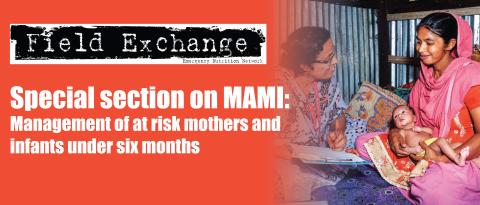Editorial
Apart from the thematic focus on MAMI1 in this 58th issue of Field Exchange (see dedicated editorial that introduces the section on page 50) we have a very diverse set of field articles and research. Rather than try to identify common threads between articles, we decided simply to highlight some of the most significant findings. Without wishing to over-sensationalise them, we thought the following might stimulate some interest:
Do families really ever starve their children to get or maintain access to programmes?
A study from South Sudan by Natalie Sessions and Regine Kopplow of Concern Worldwide found that mothers were indeed incentivised to keep children in treatment programmes for global acute malnutrition so that the family could have continued access to both the nutrition products and the general food distribution programmes (GFDs) available to families with malnourished children. There have been many anecdotal reports of this kind of behaviour where food stress has been severe, but this is one of the only studies we are aware of that has employed multiple focus group discussions and key informant interviews to highlight the problem.
At a global level, what percentage of household food comes from market purchase?
A recent blog by the relatively new Executive Director of GAIN, Laurence Haddad, states that average households in nearly all countries in the world now acquire the majority of their food from markets, most of which are packaged foods, and the market for this is growing in middle-income countries (and probably also in low-income countries). Laurence optimistically concludes and elaborates on how this presents both a business and nutrition opportunity.
Do school feeding programmes ever have a measurable impact on nutrition?
Yes – according to an article by WFP on a school feeding programme in Niger. The programme provided daily meals for girls and boys in primary schools fortified using micronutrient powders, and weekly iron and folic acid supplements provided to secondary school girls and boys. The programme significantly reduced anaemia prevalence in primary school boys and girls and secondary school boys, but not in secondary school girls (likely due to higher needs). Nutrition knowledge, dietary diversity and consumption of iron-rich foods also improved. The proportion of girls passing the school year doubled. Scale-up is using a more intensive, girls-only supplementation protocol targeting the poorest at household level, not just through schools.
How much does a nutrition survey cost?
I tend to walk around with a figure of £20,000 in my head. A recent UNICEF/Action Against Hunger review examined the implementation of SMART surveys across sub-Saharan Africa (45 countries) and the factors that have facilitated their institutionalisation. Thirty-two countries had implemented SMART surveys. Average costs are US$21,100 (about £16,400; national surveys) and US$15,050 (about £11,700; small-scale surveys) – so I wasn’t that far off.
Is the disconnect between MAM and SAM programming still taking place in current emergencies?
We’re afraid it is. In this issue we have the example from Yemen. An article by Najwa Al-Dheeb, Anna Ziolkovska and Stanley Chitekwe (UNICEF) describes how community-based management of acute malnutrition (CMAM) programming, introduced in 2009, has evolved to meet increased caseload and now includes mobile teams, integration with vaccination and community health worker services, and increased geographical coverage. Progress is reflected in significant improvement in cure rates, defaulter rates and estimated number of deaths averted (over 221,669 deaths of children under five years old were averted between 2012 and 2017). However, management of acute malnutrition (MAM) treatment scale-up has not kept pace with severe acute malnutrition (SAM) treatment (48% versus 72% geographical coverage).
Misaligned scale-up between SAM and MAM is not unusual in the articles we feature in Field Exchange; SAM scale-up dominates. This is partly what has prompted us to embark on producing a special edition in 2019 which will capture experience and research that addresses the continuum of acute malnutrition care.
Are there any good examples of integration of CMAM into health systems?
Yes, and we have an article in this edition which makes a great case study of successful integration. In 2010 UNICEF supported integration of CMAM services (SAM treatment) into 75% of fixed health facilities in north-eastern Nigeria. In 2015 infant and young child feeding (IYCF) support and multiple-micronutrient powder (MNP) were added. Government has led scale-up of this integrated package; the number of centres has increased fourfold and the number of children treated has increased fivefold (2013-17). UNICEF’s role in scale-up has focused on supporting state government to meet immediate needs of severely malnourished children while strengthening the government health system. A minimum nutritional services package was finalised in early 2017).
We hope this short editorial has made you want to read further. Enjoy!
Jeremy Shoham
Co-Editor, Field Exchange
If you would like to write an article for Field Exchange, email Chloe Angood with ideas. We welcome contributions any time.
Endnote
1Management of At risk Mothers and Infants under six months old


